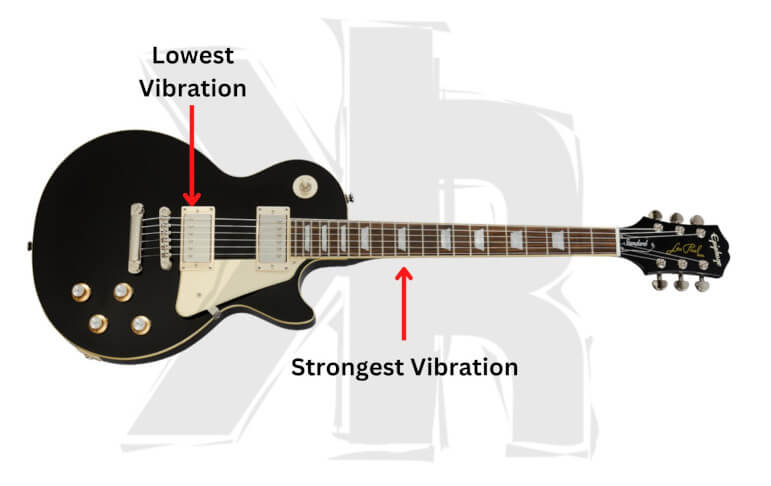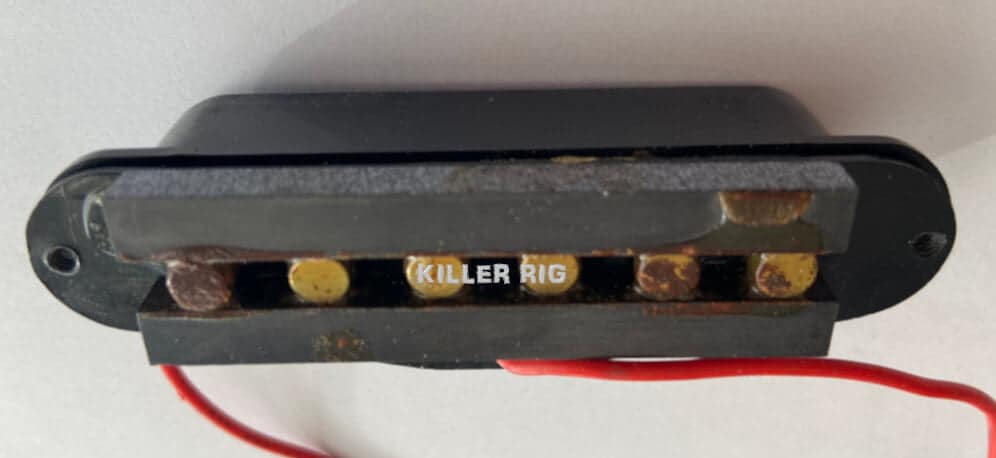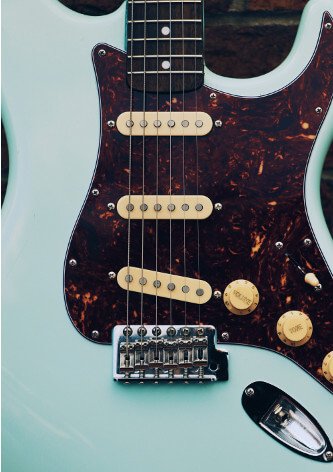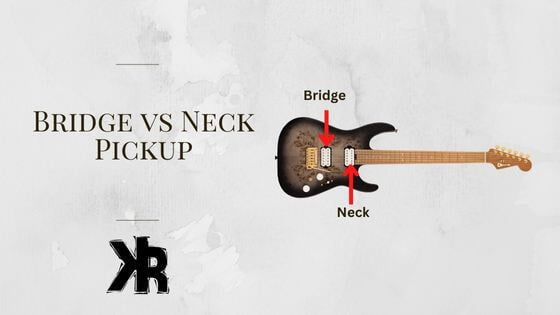Table of Contents
Bridge or neck pickup? This is unknown territory for many guitarists. But most people who play the electric guitar do so because of the different sounds that are possible. It’s a very versatile instrument!
These sounds come not only from the types of guitars available, but also from the different pickups that are found on each model.
The pickups are located in different positions on the guitar, and each one gives the instrument a certain sound. The two most common pickup positions are at the bridge and the neck.
The bridge pickup is brighter sounding than the neck, which produces a tone that is warm. The neck pickup is closer to the center of the scale length, so the string vibrations are stronger. This results in a deeper, darker sound in this position.
When it comes to the bridge vs neck pickups, which should you use and when? This Killer Rig article will answer all your questions!
Bridge Vs Neck Pickup Differences
There are many differences between the bridge and neck pickups on a guitar.
The main difference between the bridge and neck pickup is the sounds they produce. The neck pickup provides a thicker, well-rounded tone that has a stronger intensity. The bridge pickup provides a sound that is sharper and generally has more attack.
It’s for this reason that most guitar players use the bridge pickup for rhythm playing. The neck position is favored for leads and solos. Although, this also depends on the type of music that is being played.
Here is a quick summary:
| Bridge Pickup | Neck Pickup |
|---|---|
| Brighter Sound | Warm Sound |
| Farther from neck | Mounted Closer to neck |
| Lower signal ouput | Higher Intensity Signal |
| Used more for Rhythm Tone | Preferred for leads and solos |
Let’s take a look at some of these differences in a bit more detail.
Pickup Positions
The point where the guitar strings vibrate the most is right in the middle of the bridge and the nut. This is called the scale length, and it’s here that the strongest signal is possible for a pickup to receive.
On most guitars, this is roughly around the 12th fret. But placing a pickup here is not possible for obvious reasons.
Instead, we see the pickups placed along the guitar body from the neck to the bridge. This is to capture as many sounds as possible and give us versatility in our tone.
Leo Fender placed the neck pickup as close to this center point. He knew that the tone was so much thicker and rich. When this is done with single-coil pickups, it offers players so many more sounds.
With the invention of the humbucker, things changed. The difference between the bridge and neck position became that much greater.
With a bright sound at the bridge, and a warm, deep tone at the neck, the mounting position of a pickup is super important.
As you can see, the sounds are much different depending on where they are placed on the guitar. Sometimes you might even see the bridge pickup angled to balance tones.

Output Levels
The vibration of the strings is greater at the neck pickup. It results in higher output from that position.
The bridge pickup, on the other hand, produces less output. This is because it’s farther away from the center of the strings. It has fewer vibrations above it to excite the magnetic field.
This is dealt with by wiring the bridge pickup to have more output than the neck. This balances the output of both guitar pickups so that you don’t have large volume drops. Or level boosts when switching between them.
It also means that they must be installed in the right positions. What happens if you put the bridge pickup in the neck position? The output will be very loud and might be too hot for the amplifier you are using.
It’s quite common to find that bridge pickups will have a higher electrical resistance.
Sustain
The sustain of a note is how long it lasts after you pluck the string. The longer the sustain, the more vibrato you can add to the note.
The position of the pickup also plays a role in how much sustain you can expect. The neck pickup is closer to the center of the scale length.
It will provide more sustain as this is the point the strings vibrate the most, and longest. This results in more sustain from the neck pickup.
The bridge pickup will have less sustain because it’s farther away from the center of the strings. This difference is not as dramatic as the output or tone. But it’s still something to take into account when choosing which pickup to use.
This is another reason why the neck pickup is preferred for leads and solos. Not only do you get a warmer sound, but you get longer sustain as well.
And there are many different brands making pickups. Sometimes you will find there are better options than others. But this is based on who is making them.
We have a great article on guitar sustain here!
Volume
The volume from the pickups is another thing to take into account. The bridge pickup will sound less loud than the neck. Even though the pickups are wired in a way that allows them to have roughly the same output. The neck will always sound louder.
This is because the frequencies that are present at this position are much more dynamic. As a result, this richness in tone also has the effect of making the pickup sound louder.

Manufacturing Differences
The bridge pickup doesn’t have the same string vibration above it. So the amount of turns of wire needs to be greater to have a higher output.
This is done to match the output of the neck pickup so that one is not louder than the other. So there are manufacturing differences as a result.
As more wire is added to the bobbin, the resistance is then greater as a result. This means that more wire is needed for stronger output. So the bridge pickup will have a higher resistance than the neck.
An example of this is the Seymour Duncan Hot Tele pickup set. The direct current resistance, or DCR, is higher in the bridge pickup. Here are the DCR values for both the neck and bridge pickups:
- Bridge: 16.2K
- Neck: 9.9K
As you can see, the resistance is higher in the bridge pickup. This is because it has more wire wrapped around the bobbin to produce a higher output. This will bring both pickups closer in volume.
Just a side note, The Seymour Duncan Hot Tele pickups are awesome! If you own a Telecaster, you should get a set, as they will spice up your tone!
The Bridge Pickup Sound
The bridge pickup sound is typically described as being brighter or sharper. This is because the pickup is farther away from the neck and therefore picks up less bass.
As we mentioned earlier, this is a result of the lack of vibration from the strings in this position. At least when compared to the neck.
The bridge position also offers a bit more attack than the neck. This means that notes will have a sharper initial transient which really cuts through a mix. Which can be useful for certain styles of music, like:
- Metal
- Hard Rock
- Rock
- Classic or Vintage
This is why most players will use this position for rhythm parts. Even palm mutes have a different response and create heavy-sounding, mid-range focused riffs. They are tighter and punchier and is a popular sound for modern metal.
When To Use The Bridge Pickup
Generally, the use of the bridge pickup comes into play when a guitarist wants a bright and clear sound. It will also have a tight bass response. This can be done with the use of a single coil or humbucker pickup, depending on what is installed in the guitar.
A single coil will be very bright and twangy sounding. This is preferred for some music styles like country or even classic rock.
If you have ever played a Fender Stratocaster, you know how bright that can get.
However, with a humbucker in the bridge position, the tones can be great for tight hard rock and metal. Something that the neck pickup is just not capable of. And so for rhythm tones that have the right balance of frequencies, the bridge pickup is perfect.
The Neck Pickup Sound
The neck pickup is going to have a warmer and smoother response than the bridge. This is because it’s closer to the center of vibration of the strings. This gives it more low-end and mid-frequencies.
The neck position will be more mellow and also have less attack than the bridge. This makes it better for lead and melody lines.
Because of this, most players will use the neck pickup for lead parts and solos. But, depending on the sound you are going for, it can also be used for rhythm with no problems.
The neck pickup also offers a bit more sustain than the bridge because of its position. This can be useful for players who want to add vibrato or bend notes without losing the note altogether.
When To Use The Neck Pickup
The neck pickup is best used when you need a warm and smooth response. This might be for:
- Soloing
- Clean Parts
- Bends and Vibrato
- Slides
- Finger Picking
Some players will use the neck pickup for rhythm as well when they want a full sound. This can be great for blues and jazz parts that are cleaner sounding.

Switching Between Bridge and Neck Pickups
Most guitars will have a selector switch that allows you to choose which pickups are being used.
This is generally one of two options:
- 3-way switch for 2 pickup guitars.
- 5-way switch for 3 pickup guitars.
The position of the switch will determine which pickups are being used. This can be both the neck and bridge together, or just one at a time. The use of the switch will depend on the type of pickup being used.
For example, if you have a guitar with 3 single coils, you might want to use the neck and middle position.
But if you have 2 humbuckers, you might want to use the neck and bridge position together.
The way you use the switch will also depend on the style of music. For example, if you are playing metal, you might want to use the bridge and middle position only.
But if you are playing blues, you might want to use the neck and middle position. 3 pickup guitars will have even more options when it comes to the selector switch.
They will allow you to blend the neck, middle, and bridge pickups in many ways. This offers awesome versatility.
The range of sounds available is incredible. Which is why the Fender Stratocaster is such a popular guitar.
What About Guitars With 3 Pickups?

Many guitars will have 3 pickups, which gives you even more options. These can be a combination of single coils and humbuckers or all of the same type.
The most common configuration is a neck and bridge humbucker with a single coil in the middle. This is because it offers great versatility. All while still giving you the option for a brighter sound.
The middle pickup is going to be between the neck and bridge in terms of output and tone. This is because it’s picking up vibrations from another position. Where the dynamics are different from the neck or bridge locations.
The use of the middle pickup will depend on the configuration. If it’s a single-coil, it might add just the right balance for some players.
If it’s a humbucker, it can offer a great way to add more grit and midrange to your sound.
Single Pickup Guitars
Some guitars come with only a single pickup. In this case, you don’t have the option of switching between neck or bridge. So why do these guitars exist? Some people argue that you only need one pickup? That they can get plenty of sounds from just one.
And while this might be true, they may also not need a large range of tones. So one pickup guitars are great!
The pickup is also positioned closer to the middle of the guitar. It’s still closer to the bridge because you want tighter sounds. But it’s warmer, so it meets a good balance. And for some, it’s all they need!
Other Factors that Affect your Sound
Your guitar pickups are important, it’s true. But there are other factors combined that produce your final tones. This includes, guitar effects, amplifiers and more! So before writing off a set of pickups, try experimenting in other places.
Consider your effects. Do they suck tone? Some are not built well and reduce treble frequencies. Try removing it from your setup and see if your sound improves.
Try different amp settings? Sometimes you simply need to make a small adjustment. This can have a large impact!
Conclusion
The bridge and neck are the two most common types of pickups on electric guitars. They each have their unique sound that can be used for different styles of music.
These suggestions are most commonly used among guitar players. But it’s best to experiment to find the sounds that are perfect for you.
FAQs
Is the bridge or neck pickup hotter?
The neck pickup is hotter as it’s positioned under the strings where they vibrate more. This provides an output that is stronger and richer in frequencies.
Can you use both pickups at the same time?
Yes, you can use both pickups at the same time. This is done by using the switch to select both pickups and will result in a sound that is full and bright.
Is bridge or neck pickup for distortion?
They can both be used for distorted riffs and leads! It really just depends on what you’re going for.
If you want heavy, distorted sounding riffs, use the bridge pickup. However, if you want searing leads that are thick and have great sustain, use the neck pickup.

